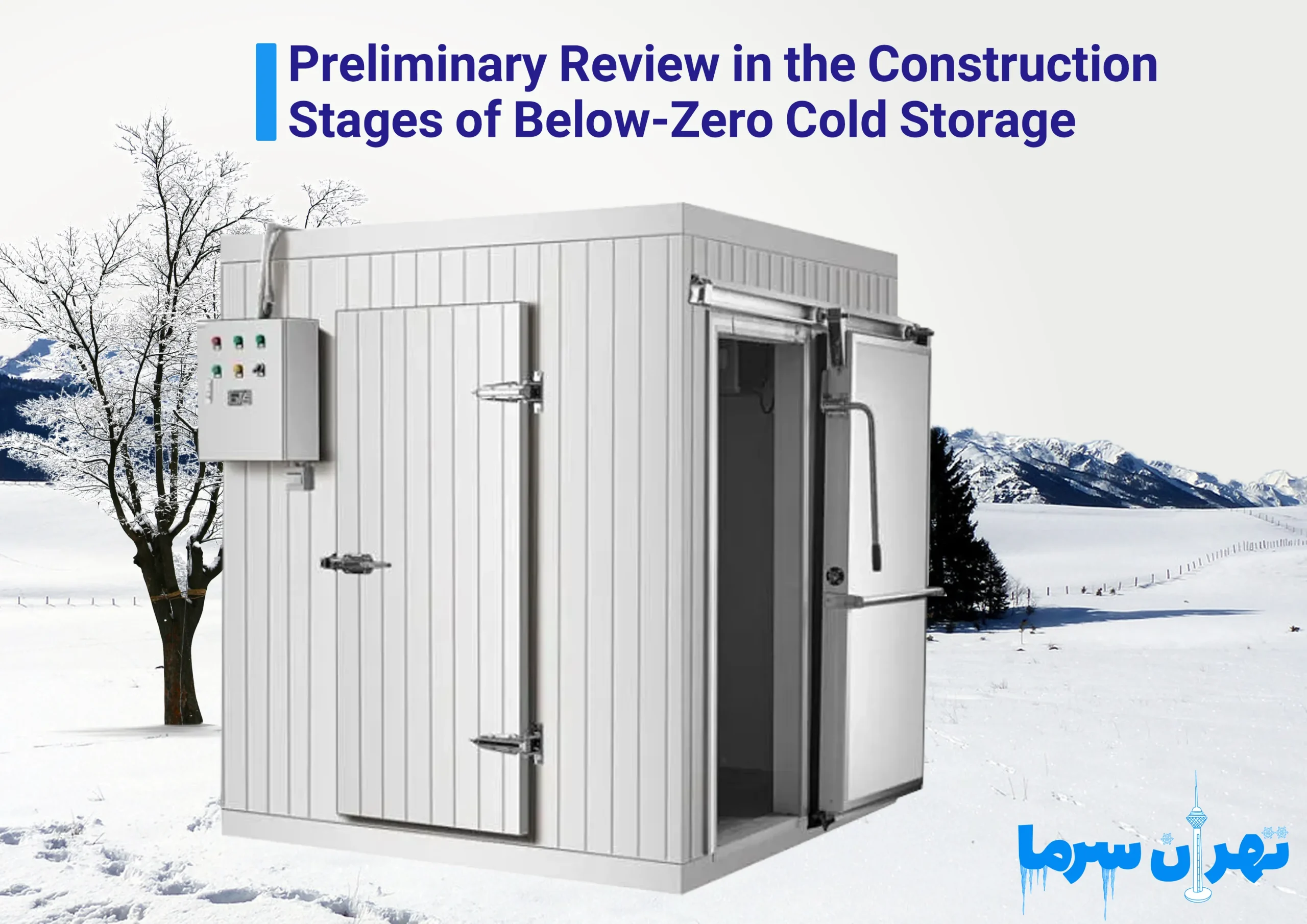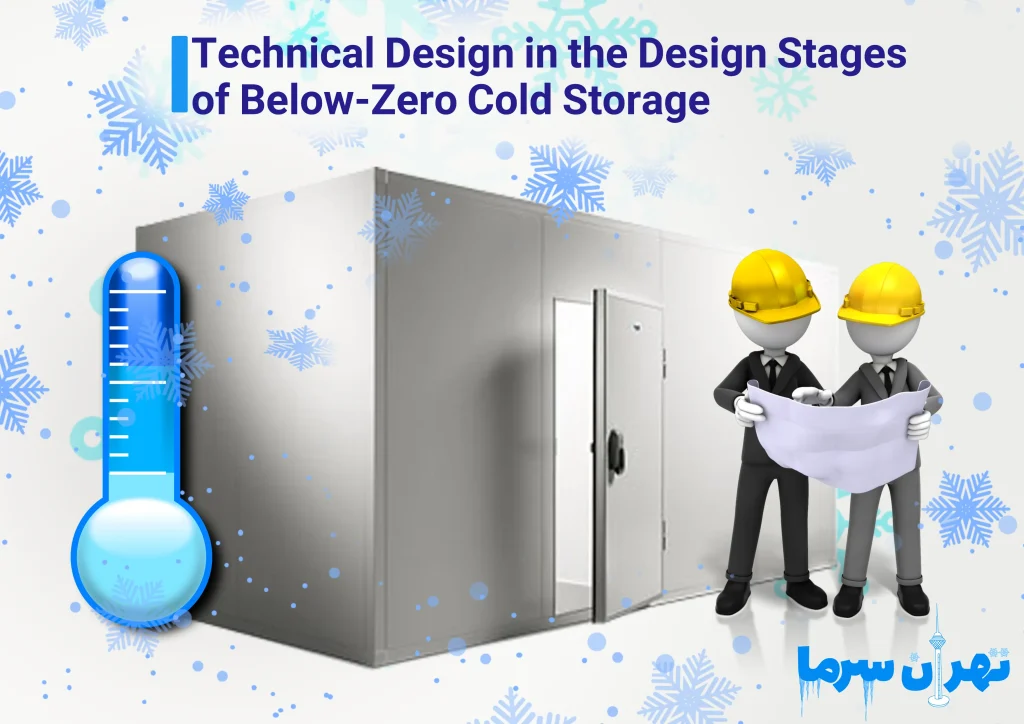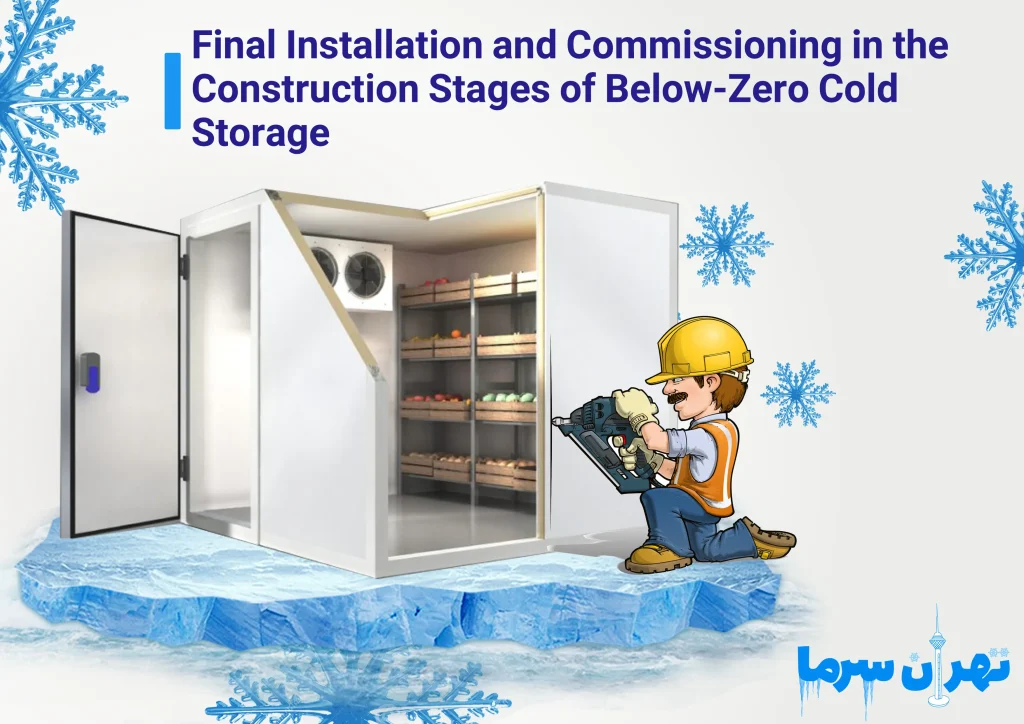Preliminary Review in the Construction Stages of Below-Zero Cold Storage

The construction and design stages of below-zero cold storage are among the very first and fundamental steps in creating a secure environment for storing temperature-sensitive food products. These stages not only include selecting the most appropriate type of thermal insulation, refrigeration equipment, and compressors, but also precise layout of components and consideration of the region’s climatic conditions. Step-by-step review of the below-zero cold storage construction stages under engineering supervision is highly important.
The preliminary review in the construction stages of below-zero cold storage marks the beginning of a complex, specialized, and fully engineering-driven process that forms the technical and operational foundations of the project. This seemingly basic step plays a fundamental role in the success or failure of the project, and if not conducted correctly and analytically, it can lead to flawed designs, additional costs, and reduced cold storage performance in the future.
Consequently, thorough and comprehensive attention to this stage is absolutely essential for all below-zero cold storage projects, especially in industrial, pharmaceutical, food, and logistics applications.
The Importance of Accurate Product Identification in the Construction Stages of Below-Zero Cold Storage
The first step in the preliminary review is the accurate identification of the types of products to be stored in the cold storage. Food items such as meat, poultry, fish, ice cream, seafood, or pharmaceutical products each have their own specific temperature and hygiene requirements.
For example, storing ice cream requires lower temperatures than red meat, and these subtle differences determine the choice of refrigeration system type, temperature class, and even the type of insulation used. Therefore, understanding the exact nature of the goods and their physical and chemical characteristics forms the basis of the initial design.
The Importance of Considering Storage Capacity in the Design Stages of Below-Zero Cold Storage
Next, attention must be paid to storage capacity and product turnover rate during the construction stages of below-zero cold storage. The quantity of products entering and leaving during each period directly influences the cold storage volume, compressor capacity, refrigeration load, and even the design of doors and traffic routes.
This information forms the basis of subsequent technical calculations, and without it, design may be severely suboptimal. Moreover, future business growth projections and the need for capacity expansion should be considered at this stage to ensure flexible and scalable design.
Climatic conditions of the cold storage site are another key factor in the preliminary review. If the project is located in hot and humid regions such as southern Iran, the thermal resistance of the structure and the cooling capacity of the equipment must be increased.
On the other hand, in cold regions, the risk of freezing in external components and piping must be accounted for in the design. Additionally, relative humidity conditions affect moisture control inside the cold storage, which can be critical for some products.
Reviewing infrastructure facilities such as electricity, water, gas, and access to logistics networks is also an important part of this stage. Below-zero cold storages usually consume high amounts of electricity and require industrial three-phase power with high capacity.
If adequate infrastructure is lacking, alternative solutions such as installing dedicated transformers or backup generators should be considered. Likewise, access to transportation roads, loading space, and container placement near the cold storage must be evaluated during initial studies.
The Importance of Reviewing the Construction Stages of Below-Zero Cold Storage
Finally, legal requirements, hygiene standards, obtaining permits, and coordination with relevant organizations must be included in the preliminary review. In cold storage projects, non-compliance with regulations from organizations like the Food and Drug Administration or Ministry of Health can lead to significant delays and even project stoppage. Therefore, precise knowledge of legal frameworks and regional regulations is an essential requirement of this stage.
The preliminary review in the construction stages of below-zero cold storage goes beyond a simple assessment; this stage requires an engineering perspective, deep understanding of operational needs, and mastery of the project’s execution and legal aspects. Any negligence at this step can lead to a faulty foundation for the entire project. Hence, the involvement of experienced experts at this stage ensures the long-term success of the cold storage.
Technical Design in the Design Stages of Below-Zero Cold Storage
Technical design in the design stages of below-zero cold storage is considered one of the most sensitive and complex parts of the construction process of such specialized facilities. At this stage, the data collected during the preliminary review are converted into drawings, engineering calculations, and technical specifications.
The goal of the technical design is to create an accurate, optimized, and executable plan that can provide stable, safe, and product-appropriate performance at very low temperatures under real conditions. Neglecting technical details at this stage can have irreversible consequences on system efficiency, energy consumption, and refrigeration system durability.
At the beginning of the technical design, engineers calculate the cooling load; this calculation determines how much heat the refrigeration system must remove from the cold storage space per unit of time. This figure is influenced by factors such as cold storage dimensions, product type, traffic frequency, weather conditions, heat transfer coefficient of walls, and door opening frequency.
An accurate estimation of the cooling load forms the basis for selecting main equipment such as compressors, condensers, and evaporators. The smallest error in these calculations can cause system inefficiency, increased electricity consumption, or even damage to the products.
Next comes the cold storage layout design. At this stage, different spaces such as storage rooms, equipment installation areas, control room, loading ramp, and traffic paths for forklifts or operators are precisely arranged.
In below-zero cold storages, attention to preventing thermal bridges, proper installation of frost-resistant doors, evaporator placement, and maintaining adequate airflow for uniform temperature distribution is crucial. The physical design should enhance energy efficiency while making internal operations simple and safe.
Simultaneously with the layout design, mechanical and electrical system drawings must also be prepared. In the technical design of below-zero cold storage construction, the type and routing of refrigerant piping, proper pipe sizing, location of refrigeration equipment, and placement of electrical panels and temperature and humidity sensors are determined.
In this phase, safety standards, sustainable operation requirements, and precise control and monitoring capabilities must be fully observed. Especially in large or multi-purpose cold storages, having an intelligent control system can play an important role in increasing efficiency and reducing operating costs.
Furthermore, thermal insulation design is a key focus in the technical design. The thickness and type of sandwich panels, flooring materials, sealing, and prevention of thermal weak points must all be scientifically calculated and selected. Improper insulation in below-zero cold storages leads to severe energy loss, moisture buildup, and internal freezing that disrupt the overall system performance.
All parts of the technical design must align with international standards and local requirements. Compliance with environmental safety regulations, employee health, noise control, energy consumption, and hygiene requirements for storing food or pharmaceuticals must be reflected in the drawings and technical documents. Successful design at this stage requires coordination among architectural, mechanical, control, and electrical engineering teams so that all components are integrated into a coherent and efficient framework.
Technical design in the design stages of below-zero cold storage not only maps out the project’s execution plan but also guarantees the cold storage’s accurate, cost-effective, and reliable operation in the coming years. This stage is where technical knowledge, practical experience, and understanding of real operator needs come together to create a smart and sustainable design.
Selecting Appropriate Equipment in the Construction Stages of Below-Zero Cold Storage
Selecting appropriate equipment during the construction stages of below-zero cold storage is one of the most fundamental and impactful steps that directly affects the performance, energy efficiency, durability, and maintenance costs of the cold storage. This stage serves as a bridge between engineering design and practical project implementation and must be based on precise calculations, correct understanding of operational needs, and compliance with technical and hygienic standards.
Incorrect or unprincipled equipment selection can cause reduced efficiency, increased energy consumption, accelerated wear and tear of components, and ultimately disruption in the preservation process of sensitive products.
The first and most important equipment is the compressor. The compressor is considered the heart of the refrigeration system and must be selected according to the calculated cooling load, type of cold storage application, and regional climatic conditions. For below-zero cold storages, where the internal temperature is usually between minus 18 to minus 30 degrees Celsius, it is essential to choose high-capacity compressors capable of operating at low temperatures and compatible with specific refrigerants such as R404A or R452A.
Brand, type (scroll, piston, screw), power consumption, and variable speed control capability (Inverter) are among the criteria that must be reviewed during the selection process.
Alongside the compressor, selecting a suitable condenser is also highly important. The condenser must be able to fully and efficiently transfer the heat extracted from inside the cold storage to the outside environment. In areas with high ambient temperatures, using air-cooled condensers with stronger fans and larger coils is mandatory, while in moderate or cold climates, smaller condensers with lower energy consumption can be used.
Additionally, industrial projects may require water-cooled or evaporative condensers, which demand different design and infrastructure.
Evaporators are other key components in the construction stages of below-zero cold storage. Their role is to absorb heat from inside the cold storage space and transfer it to the refrigerant. When selecting evaporators, factors such as cooling capacity, airflow rate, number of fans, installation position (wall-mounted, ceiling, or suspended), type of defrosting, and refrigerant type play significant roles.
Uniform distribution of cold air inside the space, prevention of coil surface frost, and ease of maintenance are among the important features to consider in evaporator selection.
Besides these main components, auxiliary parts such as electrical panels, temperature and humidity controllers, sensors, expansion valves, refrigerant storage tanks, filter driers, and oil pumps must be carefully chosen to maintain complete coordination among components. Especially in below-zero cold storages with harsher working conditions, precise control systems and proper automation are crucial for preventing frost, managing energy consumption, and providing timely alarms.
On the other hand, selecting appropriate thermal insulation is also considered part of the equipment. Sandwich panels with thicknesses of 15 to 20 centimeters, covered with moisture- and corrosion-resistant coatings, play a key role in preventing heat exchange with the outside environment and enhancing internal temperature stability. Using frost-resistant doors, high-quality sealing rubber, and thermal lock mechanisms also contribute effectively to maintaining uniform temperature inside the cold storage.
Success in selecting suitable equipment not only guarantees the efficiency and useful life of the cold storage but also reduces operating costs and minimizes the risk of equipment failure and product loss. This stage requires technical knowledge, practical experience, and full familiarity with brands and available products in the market, and it is best carried out under the supervision of specialized experts and in consultation with reputable suppliers.
Implementation of Infrastructure in the Construction Stages of Below-Zero Cold Storage
Implementation of infrastructure during the construction stages of below-zero cold storage is one of the most important and challenging parts of the project, ensuring durability, safety, and optimal performance of the refrigeration system. This stage includes preparing the foundation and proper flooring considering the heavy loads of equipment and products, installing high-quality thermal insulation to prevent heat and moisture infiltration, and constructing strong walls and ceilings that must be both mechanically robust and provide complete and uniform insulation.
Special attention is paid to preventing thermal bridges and weak points in the insulation during infrastructure implementation, as any defect in these areas can cause energy loss, ice formation, and serious problems in maintaining the desired cold storage temperature.
Additionally, the installation of electrical networks, refrigerant piping, and control and safety systems are performed simultaneously and with precise coordination to prepare conditions for starting the refrigeration system. All these activities require detailed planning, use of standard materials and equipment, and continuous engineering supervision to increase efficiency, prolong cold storage lifespan, and reduce maintenance costs.
Final Installation and Commissioning in the Construction Stages of Below-Zero Cold Storage
The final installation and commissioning in the construction stages of below-zero cold storage is a milestone that transforms all previous efforts and plans into an operational, efficient, and reliable system. In this phase, selected equipment is installed carefully and based on technical drawings, and all mechanical, electrical, and control connections are precisely executed to ensure full coordination among components.
After installation, commissioning includes testing the refrigeration system’s performance, adjusting temperature and humidity control parameters, conducting pressure and leak tests, and ensuring correct operation of all critical parts. Special attention is given to safety and alarm systems so that any problem can be prevented or addressed promptly.
Also, precise calibration of sensors and control devices ensures continuous and accurate monitoring of environmental conditions inside the cold storage, keeping products in optimal condition. Finally, operator training and delivery of technical documentation, including test reports and operational manuals, constitute the concluding parts of this stage, ensuring correct operation and proper maintenance of the cold storage.
Although this stage may appear to be the end of the work, it is the key to the cold storage’s durability and successful performance over time and requires accuracy, technical knowledge, and coordination among execution and supervisory teams.
?Why Choose Tehran Sarma Engineering Company for Below-Zero Cold Storage Construction
Tehran Sarma Engineering Company, with extensive experience and deep technical expertise in the design and construction of below-zero cold storages, is recognized as one of the pioneers of the refrigeration industry in the country. Utilizing up-to-date engineering knowledge, advanced equipment and technologies, and strict adherence to international standards, the company executes projects with unparalleled quality and on schedule.
The expert team at Tehran Sarma manages all stages—from preliminary review, technical design, equipment selection, infrastructure implementation to final installation and commissioning—with full responsibility and precision to ensure that the constructed cold storage achieves high efficiency, long durability, and optimal energy consumption.
Moreover, professional after-sales services, continuous technical support, and prompt responsiveness to customer needs have made Tehran Sarma the first choice of various industries in the field of below-zero cold storages. Collaborating with this company guarantees that your project will be executed with minimal risk, maximum quality, and best operational efficiency.
For more information about cold storage construction pricing, you can visit Tehran Sarma’s website or contact the phone numbers 09121906418 and 02177972256.
The construction and design stages of below-zero cold storage form the foundation for creating a reliable preservation system for temperature-sensitive products. Reviewing the construction stages of below-zero cold storage involves precise evaluation of infrastructure, selection of suitable equipment such as compressors, etc., which if done properly, ensures the quality preservation of products over time.
Source:
https://www.coldstorageus.com/




 سردخانه
سردخانه برق
برق کمپرسور
کمپرسور کمپرسور بیتزر
کمپرسور بیتزر کمپرسور کوپلند
کمپرسور کوپلند کمپرسور بوک
کمپرسور بوک کمپرسور دانفوس
کمپرسور دانفوس کمپرسور منیروپ دانفوس
کمپرسور منیروپ دانفوس کمپرسور امبراکو
کمپرسور امبراکو کمپرسور پاناسونیک
کمپرسور پاناسونیک کمپرسور سابکول
کمپرسور سابکول کمپرسور کوپلند
کمپرسور کوپلند کمپرسور اسکرال کوپلند
کمپرسور اسکرال کوپلند کمپرسورفراسکلد
کمپرسورفراسکلد کمپرسور رفکامپ
کمپرسور رفکامپ کمپرسور اسکرال دانفوس
کمپرسور اسکرال دانفوس گاز مبرد
گاز مبرد گاز R22
گاز R22 گاز R134
گاز R134 گاز R404
گاز R404 گاز R407
گاز R407 گاز R410
گاز R410 گاز R508
گاز R508 کندانسور هوایی
کندانسور هوایی اواپراتور
اواپراتور اواپراتور آرشه
اواپراتور آرشه اواپراتور صابکول
اواپراتور صابکول اواپراتور آسه
اواپراتور آسه اواپراتور نیک
اواپراتور نیک اواپراتور آرتک
اواپراتور آرتک اواپراتور نوین
اواپراتور نوین اواپراتور تبادل کار
اواپراتور تبادل کار درب
درب ساندویچ پنل
ساندویچ پنل فن سردخانه
فن سردخانه روغن کمپرسور سانیسو
روغن کمپرسور سانیسو متعلقات سردخانه
متعلقات سردخانه